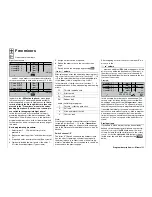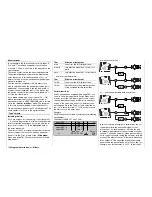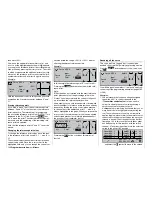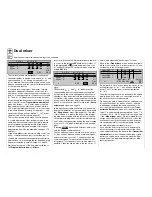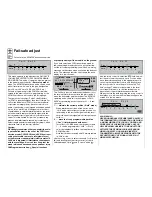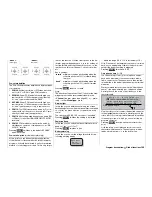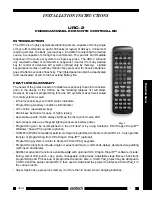
147
Program description:
Special functions
. 2 5 s
SEL
SEL
STO
Position stored
F A I L S A F E ( P C M 2 0 )
Time
Battery F.S.
off
Position
The FAIL-SAFE servo positions can be overwrit-
ten at any time – even in fl ight – by selecting the
appropriate menu and storing the transmitter set-
tings anew.
Note:
Some PCM receivers feature outputs 9 and 10,
but variable Fail-Safe settings are not available for
them; both servos move to the centre position if in-
terference occurs.
Receiver battery FAIL-SAFE
As soon as the receiver battery voltage falls below a
particular value, the servo which is assigned perma-
nently to receiver output 1 in the “Battery F.S.” sec-
tion of the Fail-Safe menu runs to one of three optio-
nal positions, with the intention of indicating to the pi-
lot that the receiver battery is failing.
Caution:
The “Battery fail-safe” function constitutes a use-
ful contribution to fl ying safety, but you should
never be tempted to rely upon it as a standard
warning of “time to land”, not least because the
discharge behaviour of batteries varies widely ac-
cording to type, and in any case the characteris-
tics of any battery change as the cells age.
You can program any of three positions as the Batte-
ry Fail-Safe setting for servo 1, and they are selected
using the right-hand SEL fi eld:
•
+75% travel in the one direction,
•
0% servo centre, or
•
-75% travel in the opposite direction.
Select your preferred servo position using the rotary
control.
. 2 5 s
SEL
SEL
STO
–75%
F A I L S A F E ( P C M 2 0 )
Time
Battery F.S.
Position
Pressing the
CLEAR
button switches the “Battery
F.S.” function off.
If the battery fail-safe signal is triggered, you can re-
gain control of the affected channel by briefl y opera-
ting the associated transmitter control (throttle stick,
or the transmitter control of a mixer input which af-
fects servo 1). This disengages the FAIL-SAFE ser-
vo, and it returns to the pilot’s commanded position.
If this should occur, you must immediately initiate the
landing approach in order to have the best possible
chance of landing the model safely.
Note:
It is perfectly possible to swap over the receiver
outputs in the »Receiver output swap« menu (see
page 153), but please note that the Battery Fail-
Safe programming always refers to receiver so-
cket No. 1, and is not affected by such actions.
W A R N I N G:
NEVER, UNDER ANY CIRCUMSTANCES, SWITCH
THE TRANSMITTER OFF WHEN YOU ARE FLYING
A MODEL AIRCRAFT! IF YOU DO, YOU RUN A SE-
RIOUS RISK OF LOSING THE MODEL, AS YOU
WILL BE HIGHLY UNLIKELY TO BE ABLE TO RE-
ACTIVATE THE RF SIGNAL QUICKLY ENOUGH
WHEN YOU SWITCH ON AGAIN, SINCE THE
TRANSMITTER ALWAYS RESPONDS WITH THE
SECURITY QUERY “RF SIGNAL ON YES / NO”
WHEN SWITCHED ON.
Summary of Contents for mx-24s
Page 1: ...1...
Page 19: ...19 For your notes...
Page 35: ...35 For your notes...
Page 41: ...41 41 For your notes...
Page 57: ...57 For your notes...
Page 63: ...63 63 For your notes...
Page 69: ...69 69 For your notes...
Page 85: ...85 85 For your notes...
Page 99: ...99 For your notes...
Page 143: ...143 For your notes...
Page 191: ...191 For your notes...
Page 212: ...212 212 For your notes...
Page 213: ...213 213 For your notes...
Page 214: ...214 For your notes...
Page 216: ...216...



